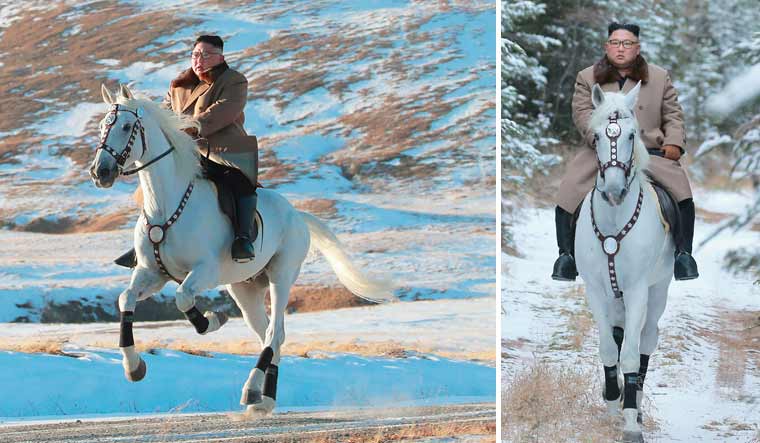In a series of images released by North Korean state media on Wednesday, Supreme Leader Kim Jong-Un is seen riding a white horse while climbing the country's sacred Paektu Mountain.
According to the Korean Central News Agency (KCNA), "He, sitting on the horseback atop Mt Paektu, recollected with deep emotion the road of arduous struggle he covered for the great cause of building the most powerful country with faith and will as firm as Mt Paektu."
According to AP news, Kim reportedly spoke out against US sanctions on his country while atop the peak, saying that his people's pain had turned into anger. He urged the Korean people to be self-reliance, reportedly stating, "We should neither want help from anyone nor lend an ear to any temptation...we should choose the prosperity based on our own efforts.".
KCNA added that “His horseback march in Mount Paektu is a great event of weighty importance in the history of the Korean revolution,” and that “All the officials who accompanied him to the top of the mountain felt overflowing emotion and joy and [were] convinced that there will be a great operation to strike the world with wonder again and advance the Korean revolution a step forward.”
The visit to the mountain—considered holy in both North and South Korea—is symbolic, and is something Kim does before major announcements or developments. He visited the mountain in 2013, before the killing of his uncle, and again in 2018 prior to his historic talks with the US President in Singapore.
The stunt came days after North Korea broke off talks with the US on October 6, with Kim saying the US had “disappointed us greatly and dampened our enthusiasm for negotiation by bringing nothing to the negotiation table.” The DPRK began talks by testing what Japan speculated were submarine-launched ballistic missiles off the Korean peninsula’s Eastern coast.
North Korea had since set a year-end deadline for the US to change its “hostile policy”, with the country’s foreign ministry stating, “As we have clearly identified the way for solving [the] problem, the fate of the future DPRK-US dialogue depends on the US attitude, and the end of the year is its deadline.”
North Korea features Mt. Paektu on its official emblem, and the peak is also mentioned in the South Korean national anthem. As the highest peak on the Korean peninsula, it is at once symbolic and historic—believed to be the birthplace of Dangun, the founder of the first Korean kingdom.
It is also associated with the Kim dynasty, who are also known as the Mt Paektu bloodline, as Kim Jong-il was said in official propaganda to have been born in its shadow, against the sight of a double rainbow.


